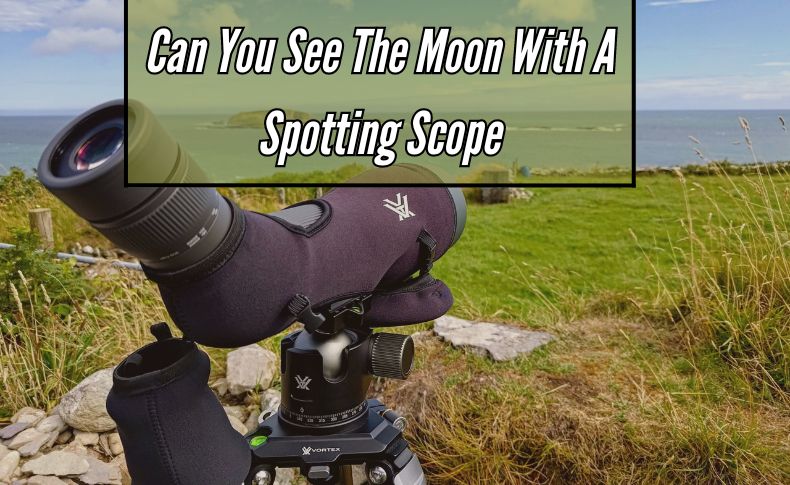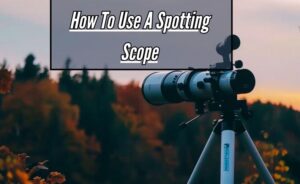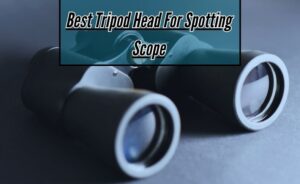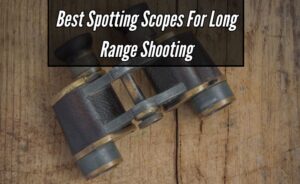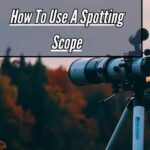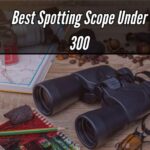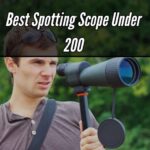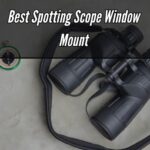Have you ever looked up at the night sky and wished you had a spotting scope to see the moon up close? The moon frequently entices us to study its craters and enigmatic surface because of its captivating presence. Although spotting scopes are more versatile than telescopes, they are nevertheless a common tool for astronomical observation.
Can You See The Moon With A Spotting Scope? Yes, a spotting scope can help you see the Moon! Because they offer sharply enlarged images, spotting scopes are perfect for observing the moon. Just watch out for focus adjustments and utilize the proper magnification settings. A spotting scope improves your experience of viewing the stars, whether you’re looking at craters or lunar phases.
We’ll explore the topic of whether you can view the moon using a spotting scope in this post. We’ll learn more about spotting scope capabilities and whether or not they can fully display the lunar surface. Thus, if you’re excited to explore the moon with me, let’s go on this lunar adventure together.
Unlocking Celestial Secrets: Moon Gazing Through a Spotting Scope
From the comfort of your garden, you can take a trip into space and explore a world full of amazing things that are just waiting to be discovered.
The moon is one of these marvels that has captivated people for eons due to its ethereal charm. This lunar excursion gains a fresh perspective with the use of a spotting scope, providing a close-up and intimate look at Earth’s nearest celestial friend.
Understanding Your Equipment: Getting to Know Your Spotting Scope
It’s important to familiarize oneself with the spotting scope before diving into the details of moon gazing. These optical devices have a robust body, an objective lens, and an eyepiece.
They are similar to telescopes but more portable. Learning how to use the features and settings on your scope will guarantee the best possible viewing circumstances and a smooth lunar encounter.
Choosing the Right Time and Place: Optimal Conditions for Moon Observation
It’s important to time your lunar observations. Good viewing conditions are best achieved on clear, cloudless evenings, particularly away from light pollution. A clearer picture of the lunar surface can be obtained by choosing an elevated viewpoint that maximizes visibility and reduces air distortion.
Seeking out the best times to observe, like full moons or partial eclipses, can also be facilitated by studying lunar calendars.
Navigating the Lunar Landscape: Exploring Craters, Seas, and Mountains
There are many geological characteristics in the area you’ll see as your spotting scope reveals the moon’s surface in fine detail. Every lunar feature narrates a tale of cosmic evolution, from broad plains to majestic mountains and complex crater formations.
Studying these particulars makes one feel awestruck by the size of the cosmos and helps one to understand the moon’s significance in forming Earth’s past.
Embracing the Journey: Finding Inspiration in Celestial Exploration
Moon Gazing offers a tremendous sense of wonder and discovery that extends beyond its scientific marvels. Every view via the spotting scope reveals a small portion of the universe’s splendor, provoking thought and contemplation.
The path of cosmic exploration cultivates a more profound connection to the cosmos and inspires an unbridled love for discovery, whether one observes alone or with other aficionados.
Through the Lens: Exploring Lunar Mysteries with a Spotting Scope

A fascinating look into the lunar secrets that have captivated people for ages can be obtained by taking a celestial tour through the lens of a spotting scope.
Our devoted companion’s surface is adorned with a mosaic of mysterious elements that reveal themselves with every new inspection. With an open mind and a voracious appetite, let’s dive into this investigation.
Unveiling Lunar Landscapes:
The lunar surface reveals itself in stunning detail when viewed through a spotting scope. A globe sculpted by cosmic forces over billions of years is depicted by craters, mountains, and valleys.
Every feature provides information about the history of our planetary neighbor by narrating stories of volcanic eruptions and meteor strikes.
Chasing Shadows:
Shadows cast by the sun’s movement across the lunar surface highlight minute details that would otherwise be hidden from view.
Through careful study of the way light and shadow interact, we are able to identify the moon’s topography with amazing accuracy. Long shadows are thrown by craters, and dramatic silhouettes against the lunar horizon are produced by rocky terrain.
Exploring Lunar Phenomena:
Numerous lunar phenomena are hidden behind the well-known craters and mountains, just waiting to be explored. The moon provides a dynamic viewing surface for everything from brief lunar occurrences to lunar eclipses. We can learn more about the lunar environment and how it is always changing by carefully tracking these occurrences over time.
Seeking Tranquility:
The peace of the lunar landscape invites us to reflect on the wonders of the universe during the quiet seclusion of a moonlit night.
We can take a break from the daily grind and enjoy the peaceful beauty of the moon by using a spotting scope as a guide. We become closer to the essence of our heavenly friend with every second we spend in silent contemplation.
Capturing Lunar Beauty:
It has never been simpler to capture the majesty of the moon through a spotting scope thanks to technological improvements. Photographers and amateur astronomers alike can now capture the remarkable clarity and detail of their moon observations for posterity. The options are unlimited, from a close-up of a lunar crater to a broad picture of the lunar plain.
Embracing the Wonder:
Let us embrace the wonder of the cosmos with open hearts and inquiring minds as we gaze through the lens of a spotting scope and investigate the lunar secrets that lie beyond.
No matter how tiny an observation may seem, it advances our understanding of the cosmos and strengthens our bonds with other worlds. Now, let’s continue exploring the lunar mysteries via the lens of a spotting scope, eyes wide open and hearts full of wonder.
Spotting Scopes and Lunar Wonders: A Guide to Moon Observation
Exploring the Moon: An Introduction
Setting off on a cosmic exploration of the night sky, the Moon is one object that never fails to enthrall us. It is a timeless light that has motivated people for countless years.
Spotting the Moon with a spotting scope can open your eyes to a whole new world of lunar delights, whether you’re an experienced astronomer or an amateur enthusiast.
Choosing the Right Spotting Scope
Having the proper equipment is crucial before beginning any moon observation. A spotting scope is your window to the universe because of its sharp optics and capacity for amplification.
To get the most out of your lunar watching experience, choose scopes with reasonably sized apertures and movable eyepieces.
Understanding Lunar Phases
The Moon offers a dynamic observation surface because of its constantly shifting phases. Every phase of the moon, from the waxing crescent to the full moon and beyond, has distinctive characteristics that are worth investigating. Learn how to read lunar calendars so that you can schedule your observation times effectively.
Spotting Lunar Landmarks
Numerous lunar landmarks are visible when you look through your spotting scope. There are many amazing sites to see on the lunar surface, ranging from the untamed nature to well-known landmarks like craters, maria, and mountain ranges. As you travel across beautiful lunar landscapes, take your time and appreciate each little detail.
Capturing Lunar Moments
With the advent of digital photography, it is now easier than ever to take beautiful moon photos. With the help of adapters, you can connect your smartphone or camera to your spotting scope and start having fun. Try a variety of exposure settings and framing strategies to capture the essence of your lunar observations.
Joining Lunar Observation Communities
Although moon gazing is a hobby that many people throughout the world share, it can also be a lonesome activity. To make connections with other lunar observers, sign up for local meetups, astronomy groups, or internet forums. You may make your trip into space more enjoyable by exchanging advice, talking about lunar occurrences, and sharing experiences.
The Moon Unveiled: A Unique Perspective with Spotting Scopes
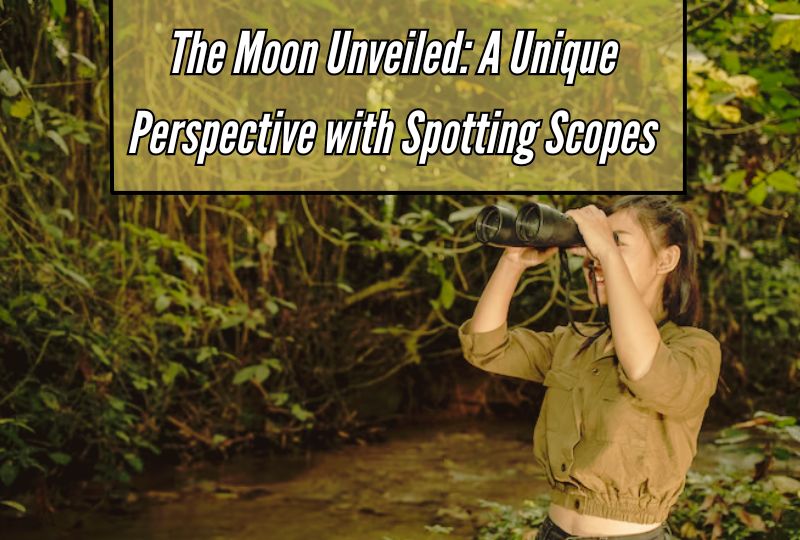
Spot scopes provide a unique perspective of the moon’s surface, so explore the fascinating world of lunar exploration with one.
With the help of these adaptable instruments, aficionados can find remarkably clear data about craters, mountains, and lunar seas, leading to a greater comprehension and admiration of Earth’s celestial friend.
Discovering the Moon Through Spotting Scopes
For those who are embarking on a journey to unravel its mysteries, using spotting scopes to examine the moon gives a unique perspective.
Unlike telescopes, however, spotting scopes offer a flexible and portable tool for researching the lunar surface. The portability of the moon allows lovers of all skill levels to view its splendor from a multitude of angels.
Enhancing Lunar Observation with Spotting Scopes
Spotting scopes equipped with state-of-the-art optics provide remarkable clarity and detail, enabling spectators to precisely distinguish minor features such as mountains, seas, and craters on the moon.
This enhanced viewing experience allows for a deeper understanding of the lunar surface topography and geological structure.
Capturing Lunar Phenomena Up Close
Photographing the phases, eclipses, and fleeting lunar occurrences of the moon with a spotting scope that works with a camera is an amazing experience for enthusiasts.
Observers can create a sense of community among lunar aficionados worldwide by sharing and immortalizing their lunar experiences through the use of DSLR or smartphone cameras.
Exploring Lunar Geography in Real-Time
The ease of hands-free observation is provided by spotting scopes with motorized mounts and electronic tracking systems, which enable users to easily travel the lunar terrain in real-time.
This interactive experience offers a dynamic viewpoint of the moon’s constantly shifting look as it moves across the night sky.
Engaging in Citizen Science Initiatives
The accessibility of spotting scopes has spurred a resurgence of interest in lunar observation among amateur astronomers and citizen scientists.
Collaborative projects such as lunar mapping initiatives and crater counting campaigns harness the collective efforts of enthusiasts to contribute valuable data to scientific research.
Fostering a Connection with the Cosmos
Beyond scientific exploration, observing the moon through spotting scopes fosters a profound connection with the cosmos, inspiring awe and wonder in observers of all ages.
Whether gazing at the moon’s serene beauty or contemplating its place in the vast expanse of space, each lunar encounter offers a moment of reflection and appreciation for the wonders of the universe.
Beyond Binoculars: Spotting Scopes for Captivating Moon Views
Binoculars are a great place to start when it comes to exploring the night sky, but a spotting scope can elevate your stargazing experience to new heights with its incredibly stunning views of the moon.
This is a thorough examination of the reasons why spotting scopes are the best instrument for moon observation.
Enhanced Magnification:
When compared to binoculars, spotting scopes usually have a higher magnification, which lets you zoom in closer to the moon’s surface and see fine details like craters, mountains, and lunar seas.
The lunar scenery is brought into clear focus, making for a more engaging viewing experience thanks to the increased magnification.
Superior Light Gathering:
Spotting scopes collect more light than typical binoculars because of their larger objective lenses, which produce crisper and more vivid moon views. In order to provide the best vision and image clarity when studying the moon during different lunar phases or in places with light pollution, this increased light gathering capabilities is especially helpful.
Adjustable Eyepieces and Focus:
Adjustable eyepieces and focus mechanisms are common on spotting scopes, so you can customize your viewing experience to your liking.
Spotter scopes provide flexibility and modification options to improve your lunar observations, regardless of your preference for a large field of view or maximum magnification.
Stability and Mounting Options:
For stable viewing sessions, a lot of spotting scopes have tripod mounts or are compatible with tripod adapters, which offer stability and reduce hand tremor. This stability is essential for moon observations, particularly at high magnifications, where even small motions can cause noticeable image distortion.
Furthermore, using a tripod to attach your spotting scope allows you to use it hands-free, which makes it simpler to follow the moon’s passage across the night sky.
Portability and Durability:
Despite the fact that certain spotting scopes are heavier and larger than binoculars, they are still rather portable and small, which makes them ideal for both close-up and distant stargazing excursions.
Spotting scopes with waterproof and fog-proof construction are designed to endure harsh outdoor conditions and are robust enough to function well in a variety of settings.
Photography and Astrophotography Capabilities:
If your spotting scope is compatible with a camera adapter, you can use it for astrophotography, which lets you take beautiful pictures of the moon and other celestial objects.
Spotting scopes provide an adaptable platform for obtaining amazing lunar photos and inspiring others to share their love of astronomy, regardless of experience level as meteorologist.
Optical Marvels: How Spotting Scopes Transform Moon Watching

Exploring the world of moon watching reveals a plethora of marvels that are hidden in the night sky. Spotting scopes are among the many equipment used by enthusiasts, but none are more essential than these optical wonders.
These tools, which are highly regarded for their accuracy and clarity, have completely changed how we view the moon.
Spotting Scopes: The Gateway to Lunar Exploration
The gap that exists between the unaided eye and the fine details of the lunar surface is filled up by spotting scopes.
These scopes allow users to see deeper into the lunar terrain, showing craters, ridges, and other astronomical features with astonishing clarity. Their magnification powers range from modest to spectacular.
Enhancing the Viewing Experience: Unveiling Hidden Details
The capacity of spotting scopes to reveal obscure details makes it one of the most alluring uses for moon viewing. These scopes enhance the viewing experience, enabling enthusiasts to see the moon in all its cosmic grandeur, from the powerful majesty of lunar craters to the delicate details of lunar mares.
Capturing Lunar Moments: Photography Through the Lens of a Spotting Scope
Spotting scopes provide opportunities for spectacular moon imagery that go beyond simple observation. These scopes allow fans to capture and store brief glimpses of heavenly splendor for future generations by allowing them to be outfitted with appropriate cameras.
Choosing the Right Tool: Navigating the World of Spotting Scopes
It might be difficult for novice moon watchers to navigate the wide variety of spotting scopes available. When choosing the best instrument for one’s lunar exploration activities, factors like portability, magnification power, and aperture size are all very important.
Embracing the Lunar Journey: Tips for Optimal Moon Watching
A few pointers might make moon gazing more enjoyable for enthusiasts as they set out on their lunar adventure. The key to realizing the full potential of these optical marvels is to have patience, align the spotting scope properly, and create ideal viewing conditions.
Moonlit Adventures: Spotting Scopes and the Lunar Landscape
The ethereal radiance of moonlit evenings captivates imaginations, lending them a unique attraction. Among the stunning lunar terrain, spotting scopes become essential equipment for the intrepid traveler.
These optical marvels allow us a deeper look at the celestial show overhead, opening up new avenues for discovery.
Understanding Spotting Scopes: A Primer for Nighttime Adventures
Spotting scopes, which are usually employed for on-land observations, go through a metamorphosis when they are illuminated by the moon. They act as windows into the lunar world, bringing far-off craters and rocky landscapes into crisp focus because of their robust build and excellent optics.
These tools enable aficionados to explore the celestial canvas more deeply thanks to their precision focusing and adjustable magnification.
Navigating the Lunar Landscape: Tips for Optimal Observation
Strategic placement is essential as you set off on your moonlit expedition. Look for areas with the least amount of light pollution to get the best visibility and contrast with the lunar features.
Try employing moon filters to reduce glare and bring out the subtler aspects of the surface, and play around with different magnifications to show intricacies that may be missed.
Chasing Shadows: Harnessing the Power of Contrast
There is no contrast like there is in the interplay of light and shadow on the lunar surface. You can reveal the complex architecture of craters, hills, and valleys with unmatched clarity by carefully placing your spotting scope to capture the interaction of light and shade. To really appreciate the moon’s mysterious beauty, learn to love its modest changes in brightness.
Capturing the Moment: Photography Tips for Lunar Enthusiasts
Spotting scopes are a great technique to take beautiful lunar photos for individuals who want to capture their moonlit adventures forever. Experiment with lengthy exposures to expose fine surface details, and pair your scope with a suitable camera adapter to take detailed pictures of the lunar surface.
With the aid of your reliable spotting telescope, take on the task of taking photos of the moon and let your imagination run wild.
Conclusion
In conclusion, spotting scopes can be used to view the moon even if their primary purpose is terrestrial observation. It might not be as enjoyable, though, as using a telescope made especially for astronomical observations. Spotting scopes provide less clear and detailed views of celestial objects like the moon since they are not as powerful as telescopes in terms of light-gathering and high magnification.
Nevertheless, a observation scope can still provide a fun experience for informal moon gazing or simple observation, particularly for novices or those on a tight budget. Therefore, even while a spotting scope may show you the moon, a telescope might be the better option if you want to become serious about astronomy.
Frequently Asked Questions (Can You See The Moon With A Spotting Scope)
Can a spotting scope be used to view the moon?
The moon can be seen with a spotting scope, yes. The moon and other celestial bodies can be observed up close with the use of spotting scopes, which are adaptable optical devices. You only need to mount the proper eyepiece on your observation scope and point it at the night sky in order to observe the moon.
The moon makes a great viewing object because of its craters and brilliant surface. Recall that amateur astronomers can readily observe the moon with a spotting scope, which can offer a closer, more detailed look at its features. The moon is a popular target.
What magnification is ideal for moon observation with a spotting scope?
The optimal magnification range for moon observation with spotting scope use is 15x to 60x. By doing this, you may preserve image clarity while still capturing details like craters and other lunar characteristics. Because of Earth’s atmosphere, higher amplifications may provide a darker image and make it difficult to maintain a steady vision.
Choose a spotting scope with an objective lens that is larger (60 to 80 mm) to get more light and improve your moonwatching experience. A clear and bright picture of the moon’s intriguing surface is ensured by striking the ideal balance between lens size and magnification.
Can a spotting scope capture moon phases?
No, moon phases cannot be captured with a spotting scope. Moon phases and other celestial occurrences cannot be captured by spotting scopes because they are made for terrestrial observation only. You would need a specialised camera with the right optics or a telescope with a built-in camera if you wanted to take pictures of the moon phases.
The necessary tracking and amplification for celestial photography are not available with spotting telescopes. If you want to see the moon, you can use a telescope or binoculars with moon filters to get a better look. However, specialised astrophotography equipment is best for taking pictures of the moon’s phases.
Is it possible to see lunar details like the Sea of Tranquility with a spotting scope?
It is difficult to use a spotting scope to view fine features like the Sea of Tranquilly on the Moon. The magnification required to see lunar details is not present in spotting telescopes because they are made for terrestrial viewing. A telescope with a higher magnification is advised to observe lunar characteristics.
You can see craters, seas, and other lunar landmarks more clearly with telescopes because they have higher resolution. Higher amplifications provide more detailed views of the moon, but for basic lunar observation, look for a telescope with at least 50x magnification. Remember that atmospheric conditions and light pollution are two examples of elements that can impact visibility.
Do I need additional accessories for moon observation?
No, further accessories are not required for simple lunar observation. It is enough to use a telescope with a respectable magnification of about 50x. To improve contrast and lessen brightness, you might want to think about using moon filters for a closer look. They can improve your experience but are not necessary.
A strong tripod can also provide stability, and a lunar map or app can aid in feature identification. In general, all you need for basic moon watching is a telescope, but you can enhance your enjoyment and comprehension of lunar intricacies by adding extra accessories.
Are spotting scopes suitable for astrophotography of the moon?
In order to take astrophotography of the moon, spotting scopes can be utilised. Suitable for collecting images of the moon’s surface, these scopes provide a closer look at lunar details. One way to improve astrophotography is to link your camera to the spotting scope with a specific camera attachment or a smartphone adapter.
Furthermore, for steady and crisp shots, a sturdy tripod is a need. For beginners or those wishing to experiment with lunar photography without making a substantial equipment investment, spotting telescopes are a more cost-effective solution than specialised astronomical telescopes, even though they might not offer the most sophisticated capabilities.

